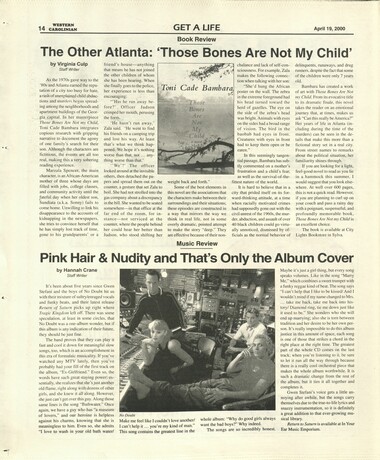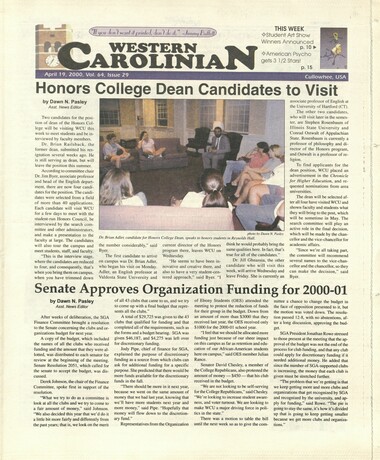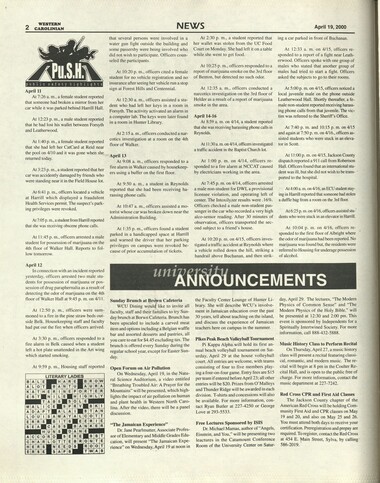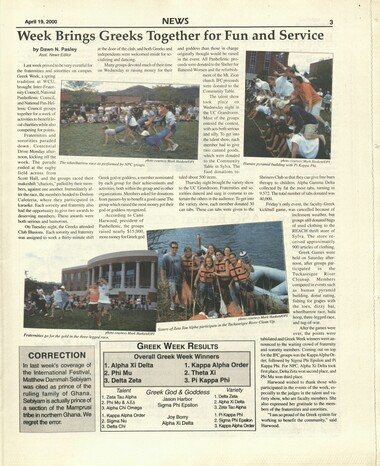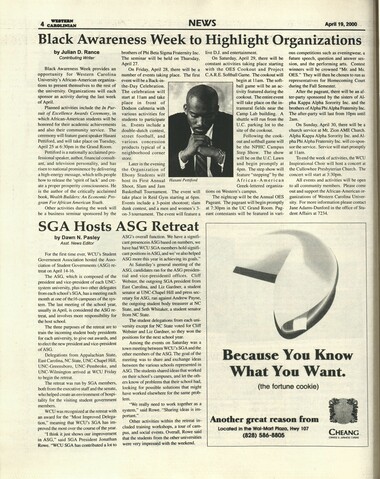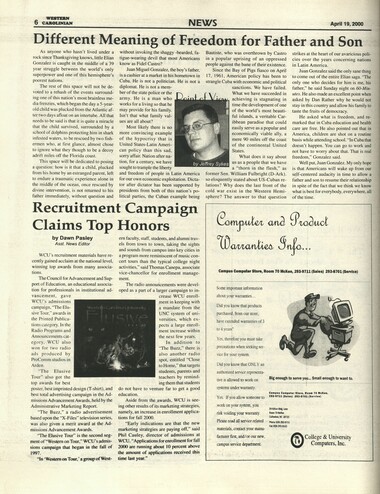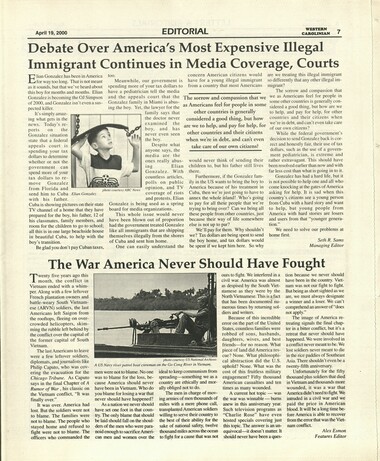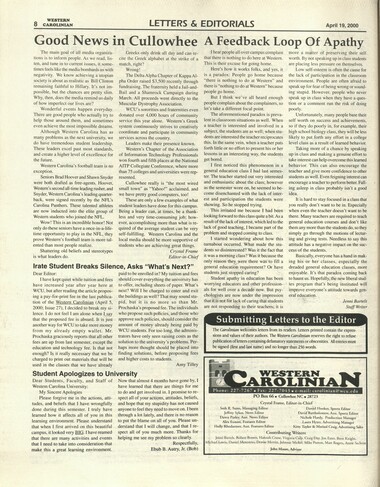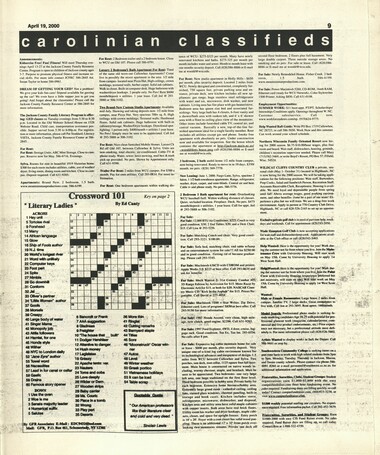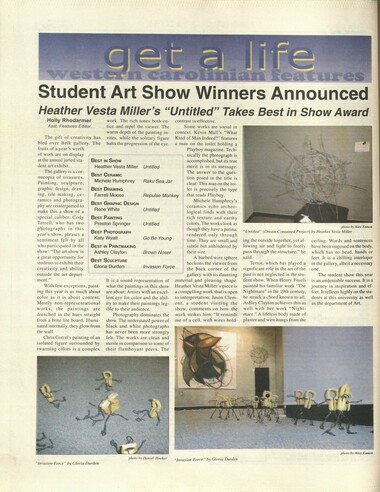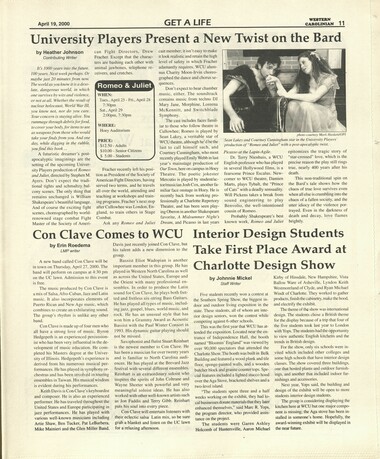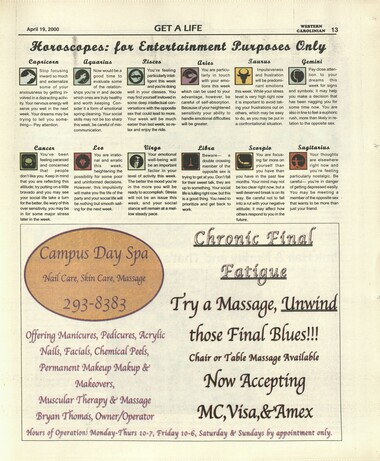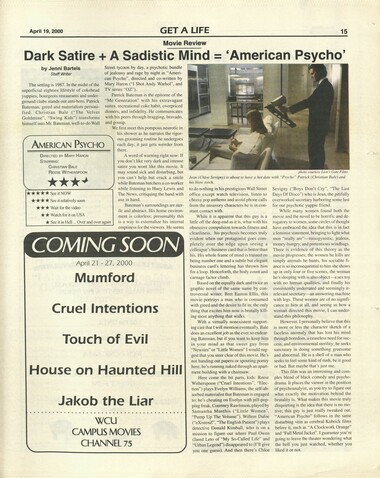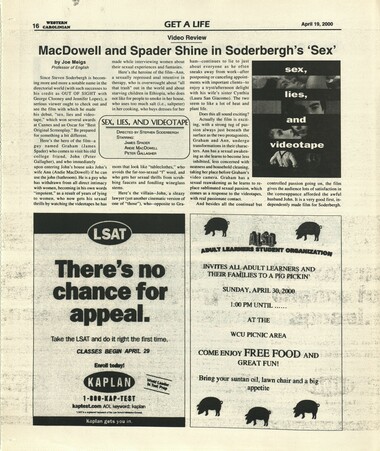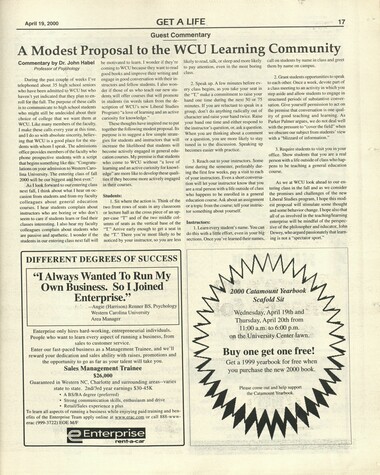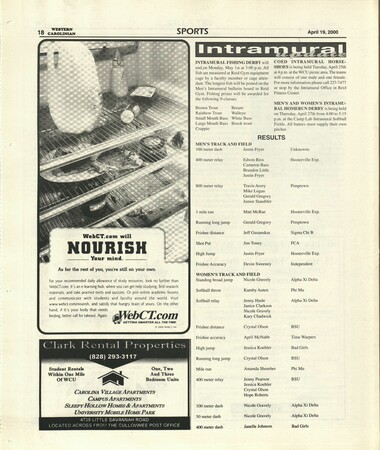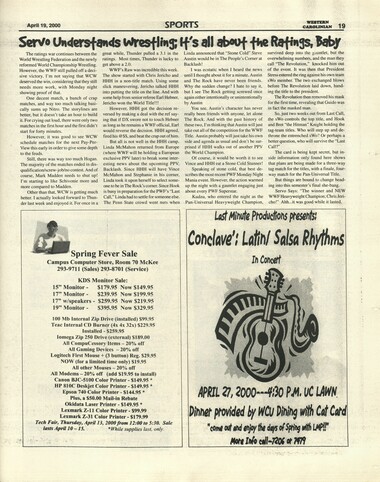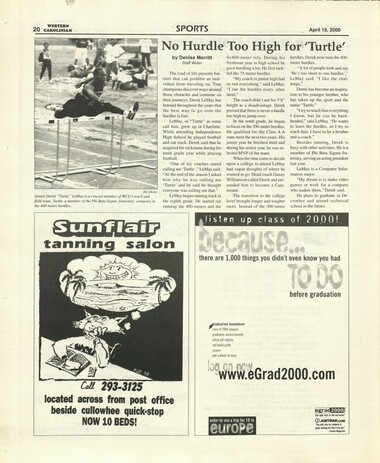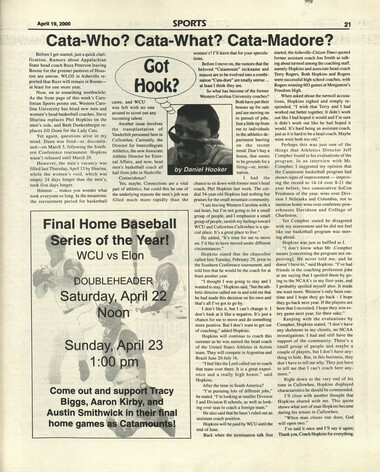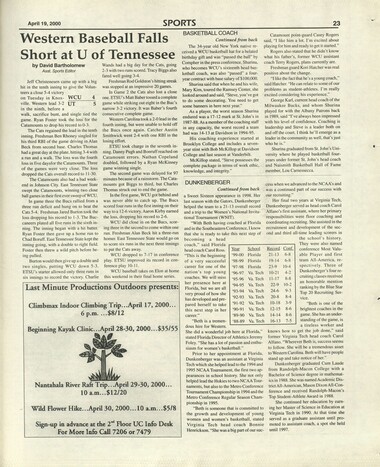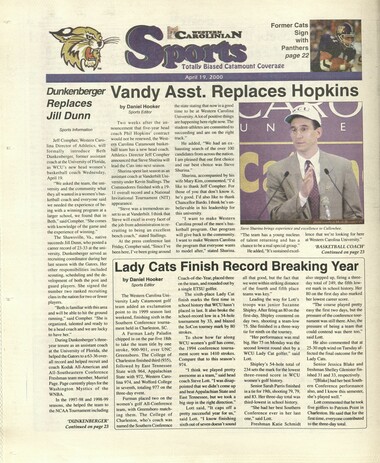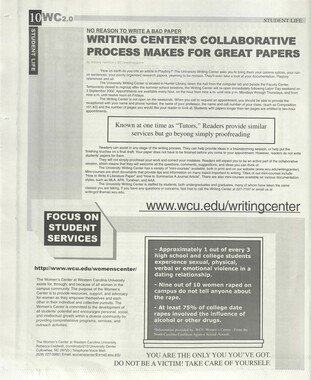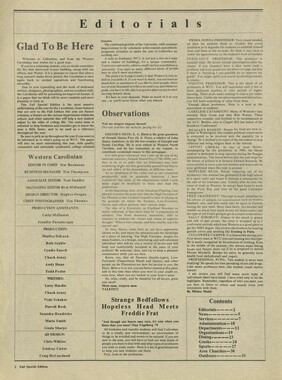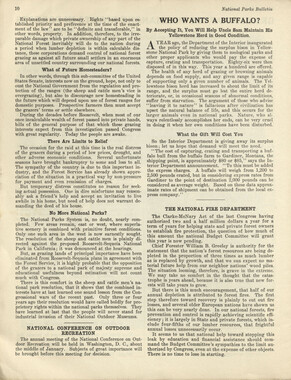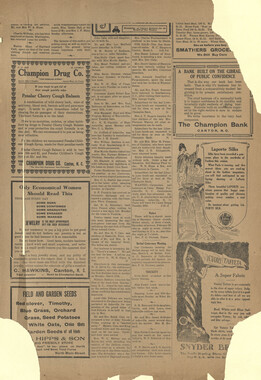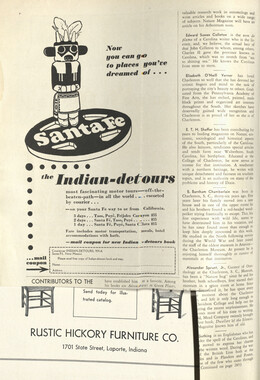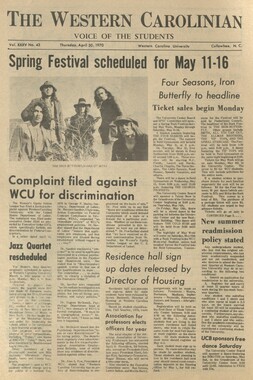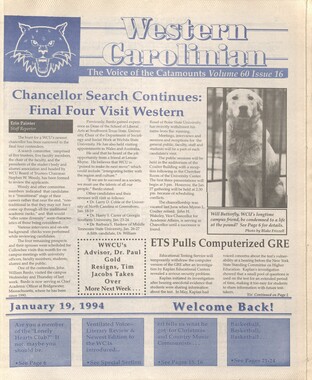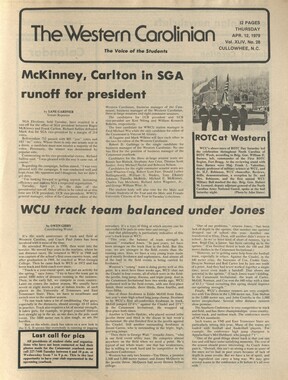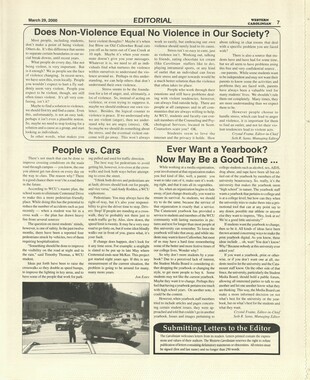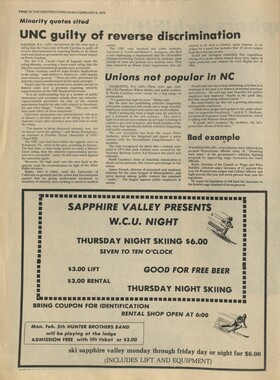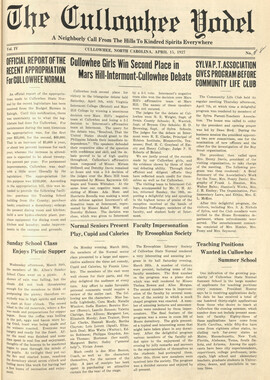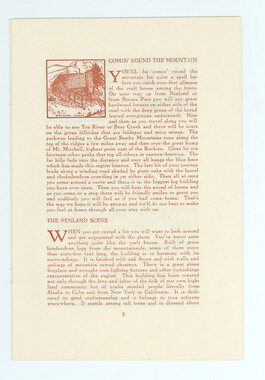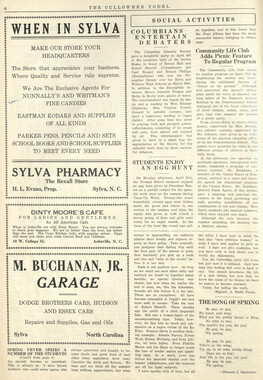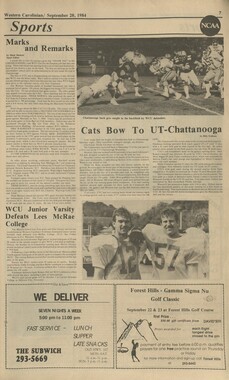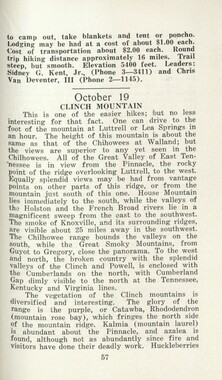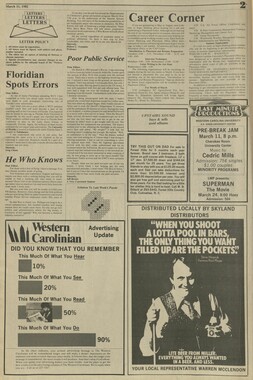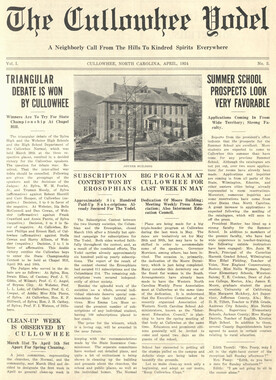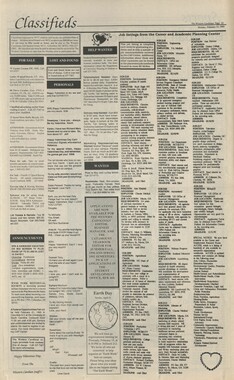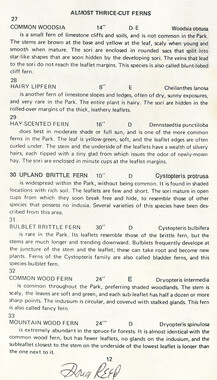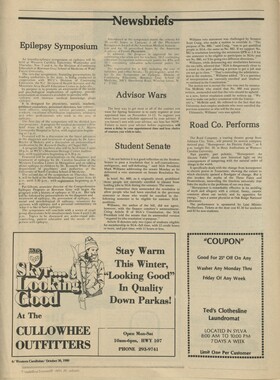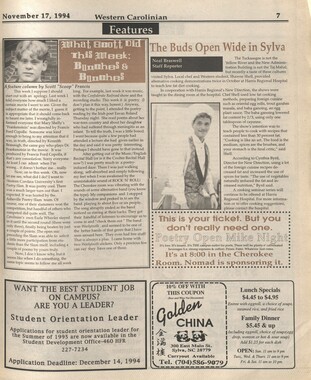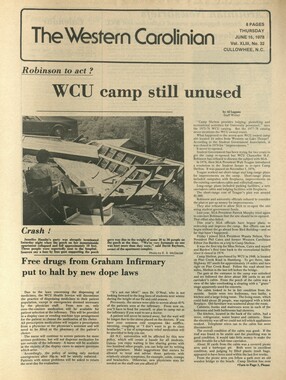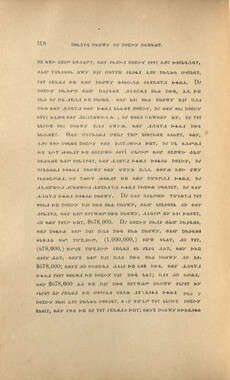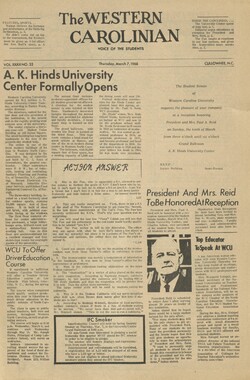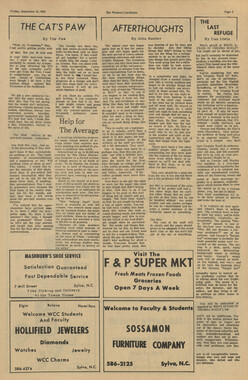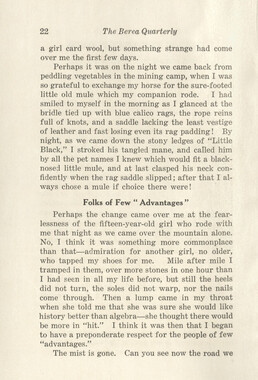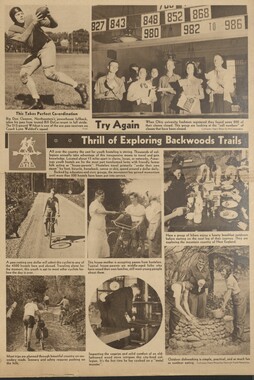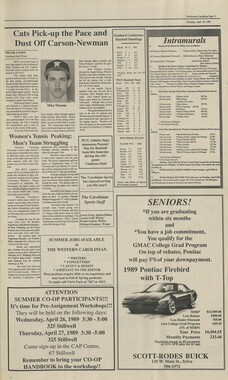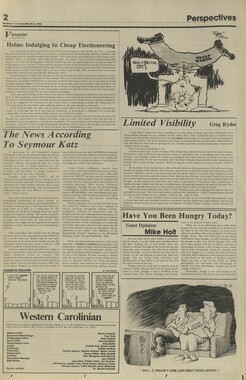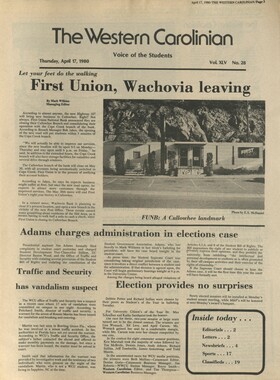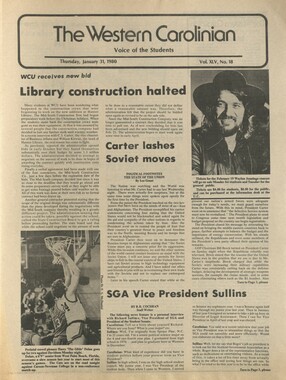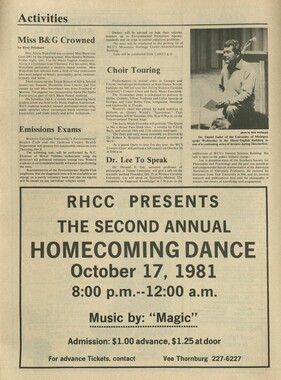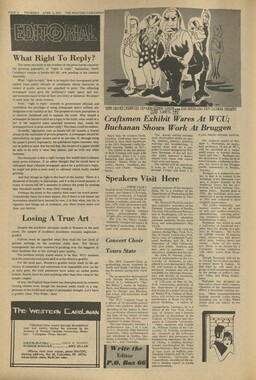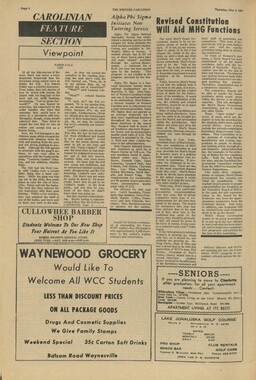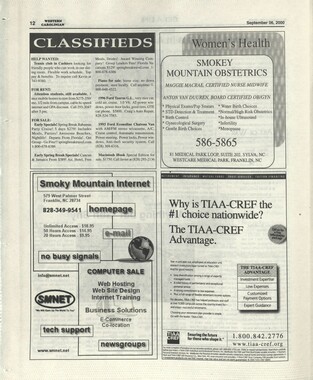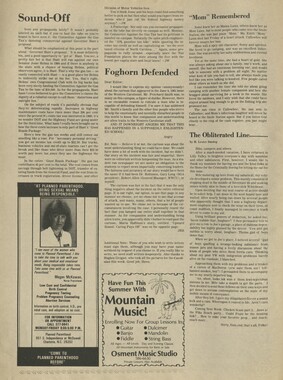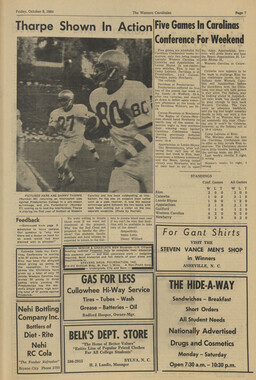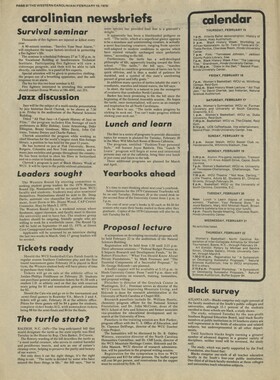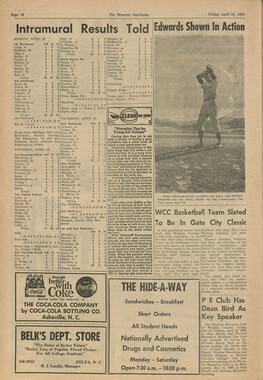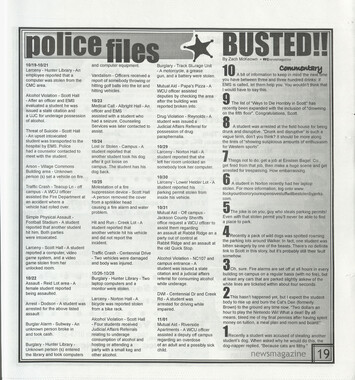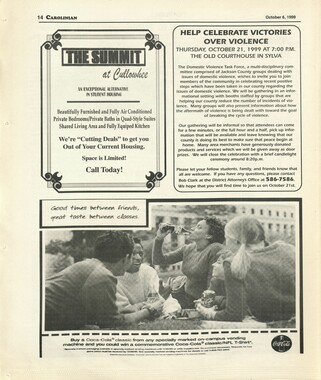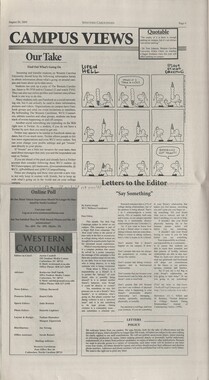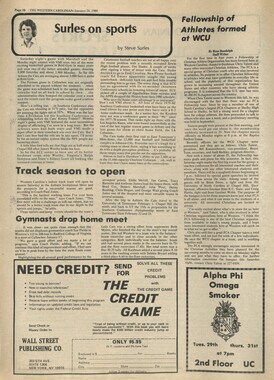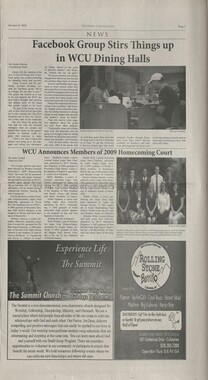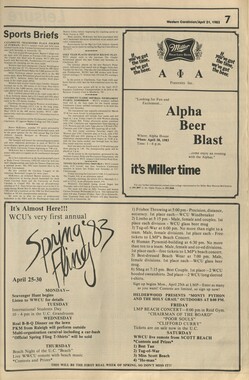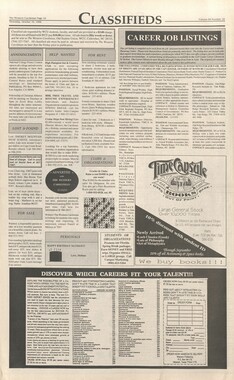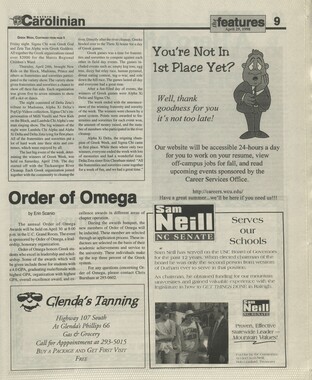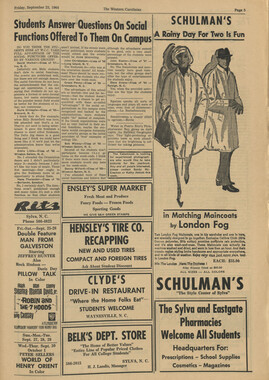Western Carolina University (20)
View all
- Canton Champion Fibre Company (2308)
- Cherokee Traditions (291)
- Civil War in Southern Appalachia (165)
- Craft Revival (1942)
- Great Smoky Mountains - A Park for America (2946)
- Highlights from Western Carolina University (430)
- Horace Kephart (941)
- Journeys Through Jackson (159)
- LGBTQIA+ Archive of Jackson County (85)
- Oral Histories of Western North Carolina (314)
- Picturing Appalachia (6873)
- Stories of Mountain Folk (413)
- Travel Western North Carolina (160)
- Western Carolina University Fine Art Museum Vitreograph Collection (129)
- Western Carolina University Herbarium (92)
- Western Carolina University: Making Memories (738)
- Western Carolina University Publications (2488)
- Western Carolina University Restricted Electronic Theses and Dissertations (146)
- Western North Carolina Regional Maps (71)
- World War II in Southern Appalachia (131)
University of North Carolina Asheville (6)
View all
- Allanstand Cottage Industries (62)
- Appalachian National Park Association (53)
- Bennett, Kelly, 1890-1974 (1463)
- Berry, Walter (76)
- Brasstown Carvers (40)
- Carver, George Washington, 1864?-1943 (26)
- Cathey, Joseph, 1803-1874 (1)
- Champion Fibre Company (233)
- Champion Paper and Fibre Company (297)
- Cherokee Indian Fair Association (16)
- Cherokee Language Program (22)
- Crowe, Amanda (40)
- Edmonston, Thomas Benton, 1842-1907 (7)
- Ensley, A. L. (Abraham Lincoln), 1865-1948 (275)
- Fromer, Irving Rhodes, 1913-1994 (70)
- George Butz (BFS 1907) (46)
- Goodrich, Frances Louisa (120)
- Grant, George Alexander, 1891-1964 (96)
- Heard, Marian Gladys (60)
- Kephart, Calvin, 1883-1969 (15)
- Kephart, Horace, 1862-1931 (313)
- Kephart, Laura, 1862-1954 (39)
- Laney, Gideon Thomas, 1889-1976 (439)
- Masa, George, 1881-1933 (61)
- McElhinney, William Julian, 1896-1953 (44)
- Niggli, Josephina, 1910-1983 (10)
- North Carolina Park Commission (105)
- Osborne, Kezia Stradley (9)
- Owens, Samuel Robert, 1918-1995 (11)
- Penland Weavers and Potters (36)
- Roberts, Vivienne (15)
- Roth, Albert, 1890-1974 (142)
- Schenck, Carl Alwin, 1868-1955 (1)
- Sherrill's Photography Studio (2565)
- Southern Highland Handicraft Guild (127)
- Southern Highlanders, Inc. (71)
- Stalcup, Jesse Bryson (46)
- Stearns, I. K. (213)
- Thompson, James Edward, 1880-1976 (226)
- United States. Indian Arts and Crafts Board (130)
- USFS (683)
- Vance, Zebulon Baird, 1830-1894 (1)
- Weaver, Zebulon, 1872-1948 (58)
- Western Carolina College (230)
- Western Carolina Teachers College (282)
- Western Carolina University (2005)
- Western Carolina University. Mountain Heritage Center (18)
- Whitman, Walt, 1819-1892 (10)
- Wilburn, Hiram Coleman, 1880-1967 (73)
- Williams, Isadora (3)
- Cain, Doreyl Ammons (0)
- Crittenden, Lorraine (0)
- Rhodes, Judy (0)
- Smith, Edward Clark (0)
- Appalachian Region, Southern (2569)
- Asheville (N.C.) (1923)
- Avery County (N.C.) (26)
- Blount County (Tenn.) (195)
- Buncombe County (N.C.) (1672)
- Cherokee County (N.C.) (283)
- Clay County (N.C.) (555)
- Graham County (N.C.) (236)
- Great Smoky Mountains National Park (N.C. and Tenn.) (519)
- Haywood County (N.C.) (3569)
- Henderson County (N.C.) (70)
- Jackson County (N.C.) (4909)
- Knox County (Tenn.) (35)
- Knoxville (Tenn.) (13)
- Lake Santeetlah (N.C.) (10)
- Macon County (N.C.) (420)
- Madison County (N.C.) (215)
- McDowell County (N.C.) (39)
- Mitchell County (N.C.) (132)
- Polk County (N.C.) (35)
- Qualla Boundary (982)
- Rutherford County (N.C.) (76)
- Swain County (N.C.) (2182)
- Transylvania County (N.C.) (270)
- Watauga County (N.C.) (12)
- Waynesville (N.C.) (86)
- Yancey County (N.C.) (72)
- Aerial Photographs (3)
- Aerial Views (60)
- Albums (books) (4)
- Articles (1)
- Artifacts (object Genre) (228)
- Bibliographies (1)
- Biography (general Genre) (2)
- Cards (information Artifacts) (38)
- Clippings (information Artifacts) (191)
- Copybooks (instructional Materials) (3)
- Crafts (art Genres) (622)
- Depictions (visual Works) (21)
- Design Drawings (1)
- Drawings (visual Works) (185)
- Envelopes (73)
- Exhibitions (events) (1)
- Facsimiles (reproductions) (1)
- Fiction (general Genre) (4)
- Financial Records (12)
- Fliers (printed Matter) (67)
- Glass Plate Negatives (381)
- Guidebooks (2)
- Internegatives (10)
- Interviews (815)
- Land Surveys (102)
- Letters (correspondence) (1013)
- Manuscripts (documents) (618)
- Maps (documents) (177)
- Memorandums (25)
- Minutes (administrative Records) (59)
- Negatives (photographs) (6090)
- Newsletters (1290)
- Newspapers (2)
- Notebooks (8)
- Occupation Currency (1)
- Paintings (visual Works) (1)
- Pen And Ink Drawings (1)
- Periodicals (193)
- Personal Narratives (10)
- Photographs (12976)
- Plans (maps) (1)
- Poetry (5)
- Portraits (4568)
- Postcards (329)
- Programs (documents) (181)
- Publications (documents) (2440)
- Questionnaires (65)
- Relief Prints (26)
- Sayings (literary Genre) (1)
- Scrapbooks (282)
- Sheet Music (2)
- Slides (photographs) (402)
- Songs (musical Compositions) (2)
- Sound Recordings (796)
- Specimens (92)
- Speeches (documents) (18)
- Tintypes (photographs) (8)
- Transcripts (322)
- Video Recordings (physical Artifacts) (23)
- Text Messages (0)
- A.L. Ensley Collection (275)
- Appalachian Industrial School Records (7)
- Appalachian National Park Association Records (336)
- Axley-Meroney Collection (2)
- Bayard Wootten Photograph Collection (20)
- Bethel Rural Community Organization Collection (7)
- Blumer Collection (5)
- C.W. Slagle Collection (20)
- Canton Area Historical Museum (2110)
- Carlos C. Campbell Collection (462)
- Cataloochee History Project (64)
- Cherokee Studies Collection (4)
- Daisy Dame Photograph Album (5)
- Daniel Boone VI Collection (1)
- Doris Ulmann Photograph Collection (112)
- Elizabeth H. Lasley Collection (1)
- Elizabeth Woolworth Szold Fleharty Collection (4)
- Frank Fry Collection (95)
- George Masa Collection (173)
- Gideon Laney Collection (452)
- Hazel Scarborough Collection (2)
- Hiram C. Wilburn Papers (28)
- Historic Photographs Collection (236)
- Horace Kephart Collection (861)
- Humbard Collection (33)
- Hunter and Weaver Families Collection (1)
- I. D. Blumenthal Collection (4)
- Isadora Williams Collection (4)
- Jesse Bryson Stalcup Collection (47)
- Jim Thompson Collection (224)
- John B. Battle Collection (7)
- John C. Campbell Folk School Records (80)
- John Parris Collection (6)
- Judaculla Rock project (2)
- Kelly Bennett Collection (1482)
- Love Family Papers (11)
- Major Wiley Parris Civil War Letters (3)
- Map Collection (12)
- McFee-Misemer Civil War Letters (34)
- Mountain Heritage Center Collection (4)
- Norburn - Robertson - Thomson Families Collection (44)
- Pauline Hood Collection (7)
- Pre-Guild Collection (2)
- Qualla Arts and Crafts Mutual Collection (12)
- R.A. Romanes Collection (681)
- Rosser H. Taylor Collection (1)
- Samuel Robert Owens Collection (94)
- Sara Madison Collection (144)
- Sherrill Studio Photo Collection (2558)
- Smoky Mountains Hiking Club Collection (616)
- Stories of Mountain Folk - Radio Programs (374)
- The Reporter, Western Carolina University (510)
- Venoy and Elizabeth Reed Collection (16)
- WCU Gender and Sexuality Oral History Project (32)
- WCU Mountain Heritage Center Oral Histories (25)
- WCU Oral History Collection - Mountain People, Mountain Lives (71)
- WCU Students Newspapers Collection (1920)
- Western North Carolina Tomorrow Black Oral History Project (69)
- William Williams Stringfield Collection (2)
- Zebulon Weaver Collection (109)
- African Americans (390)
- Appalachian Trail (35)
- Artisans (521)
- Cherokee art (84)
- Cherokee artists -- North Carolina (10)
- Cherokee language (21)
- Cherokee pottery (101)
- Cherokee women (208)
- Church buildings (189)
- Civilian Conservation Corps (U.S.) (111)
- College student newspapers and periodicals (2009)
- Dams (107)
- Dance (1023)
- Education (222)
- Floods (61)
- Folk music (1015)
- Forced removal, 1813-1903 (2)
- Forest conservation (220)
- Forests and forestry (1184)
- Gender nonconformity (4)
- Great Smoky Mountains National Park (N.C. and Tenn.) (181)
- Hunting (45)
- Landscape photography (25)
- Logging (119)
- Maps (83)
- Mines and mineral resources (8)
- North Carolina -- Maps (18)
- Paper industry (38)
- Postcards (255)
- Pottery (135)
- Railroad trains (72)
- Rural electrification -- North Carolina, Western (3)
- School integration -- Southern States (2)
- Segregation -- North Carolina, Western (5)
- Slavery (5)
- Sports (452)
- Storytelling (243)
- Waterfalls -- Great Smoky Mountains (N.C. and Tenn.) (66)
- Weaving -- Appalachian Region, Southern (280)
- Wood-carving -- Appalachian Region, Southern (328)
- World War, 1939-1945 (173)
Western Carolinian Volume 64 (65) Number 29
Item
Item’s are ‘child’ level descriptions to ‘parent’ objects, (e.g. one page of a whole book).
-
-
WESTERN 14 CAROLINIAN GET A LIFE April 19, 2000 Book Review The Other Atlanta: 'Those Bones Are Not My Child by Virginia Culp Staff Writer As the 1970s gave way to the '80s and Atlanta earned the reputation of a city too busy for hate, a rash of unexplained child abductions and murders hegan spreading among the neighborhoods and apartment buildings of the Georgia capital. In her masterpiece Those Bones Are Not my Child, Toni Cade Bambara integrates copious research with gripping narrative to document the agony of one family's search for their son. Although the characters are fictitious, the events are all too real, making this a very sobering reading experience. Marzala Spencer, the main character, is an African-American mother of three whose days are filled with jobs, college classes, and community activity until the fateful day when her oldest son, Sundiata (a.k.a. Sonny) fails to come home. Unwilling to link his disappearance to the accounts of kidnapping in the newspapers, she tries to convince herself that he has simply lost track of time, gone to his grandparents' or a friend's house—anything that means he has not joined the other children of whom she has been hearing. When she finally goes to the police, her experience is less than encouraging: '"Has he run away before?' . Officer Judson crimped her mouth, perusing the form. 'He hasn't run away,' Zala said. 'He went to find his friends on a camping trip and lost his way. At least that's what we think happened. We hope it's nothing worse than that, not ... anything worse than that.' "We"?' The officer looked around at the invisible others, then detached the papers and spread them out on the counter, a gesture that set Zala to boil. She had not strolled into the gas company about a discrepancy in the bill. She wanted to be seated somewhere—in that office at the far end of the room, for instance—not serviced at the counter, where the people behind her could hear her better than Judson, who stood shifting her Toni Cade Bambara ,s. weight back and forth." Some of the best elements in this novel are the associations that the characters make between their surroundings and their situations; these episodes are constructed in a way that mirrors the way we think in real life, not in some overly dramatic, pointed attempt to make the story "deep." They are effective because of their non- Music Review chalance and lack of self-consciousness. For example, Zala makes the following connection when talking with her son: "She'd hung the African poster on the wall. The zebra in the extreme foreground had his head turned toward the herd of gazelles. The eye on the side of the zebra's head was bright. Animals with eyes on the sides had a broad range of vision. The bird in the baobab had eyes in front. Creatures with eyes in front had to keep them open or be eaten." In this seemingly tangential passage, Bambara has subtly commented on a mother's frustration and a child's fear, as well as the survival-of-the- fittest nature of the world. It is hard to believe that in a city that prided itself on its forward-thinking attitude, at a time when racially motivated crimes had supposedly gone out with the civil unrest of the 1960s, the murder, abduction, and assault of over 40 black children could go virtually unnoticed, dismissed by officials as the normal behavior of delinquents, runaways, and drug runners, despite the fact that some of the children were only 7 years old. Bambara has created a work of art with Those Bones Are Not my Child. From its evocative title to its dramatic finale, this novel takes the reader on an emotional journey that, at times, makes us ask "Can this really be America?" Her years of life in Atlanta (including during the time of the murders) can be seen in the details that make this more than a fictional story set in a real city. From street names to remarks about the political situation, her familiarity shines through. If you are looking for a light, feel-good novel to read as you lie in a hammock this summer, I would suggest that you look elsewhere. At well over 600 pages, this is not a quick read. However, if you are planning to curl up on your couch and pass a rainy day with a poignant, suspenseful, and profoundly memorable book, Those Bones Are Not my Child is an excellent choice. The book is available at City Lights Bookstore in Sylva. Hair & Nudity and That's Only the Album Cover by Hannah Crane Staff Writer It's been about five years since Gwen Stefani and the boys of No Doubt hit us with their mixture of sultry/enraged vocals and funky beats, and their latest release Return of Saturn picks up right where Tragic Kingdom left off. There was some speculation, at least in some circles, that No Doubt was a one-album wonder, but if this album is any indication of their future, they should be just fine. The band proves that they can play it fast and cool it down for meaningful slow songs, too, which is an accomplishment in this era of formulaic musicality. If you've watched any MTV lately, then you've probably had your fill of the first track on the album, "Ex-Girlfriend." Even so, the words have such great staying power; essentially, she realizes that she's just another old flame, right along with dozens of other girls, and she knew it all along. However, she just can't get over this guy. Along those same lines is the song "Bathwater." Once again, we have a guy who has "a museum of lovers," and our heroine is helpless against his charms, knowing that she is meaningless to him. Even so, she admits "I love to wash in your old bath water/ No Doubt Make me feel like I couldn't love another/ I can't help it... you're my kind of man." This song contains the greatest line in the whole album: "Why do good girls always want the bad boys?" Why indeed. The songs are so incredibly honest. Maybe it's just a girl thing, but every song speaks volumes. Like in the song "Marry Me," which combines a sweet trumpet with a funky reggae kind of beat. The song says "I can't help that I like to be kissed/ And I wouldn't mind if my name changed to Mrs. ... take me back, take me back into history/ Diamond ring, tie me down just like it used to be." She wonders who she will end up marrying; also she is torn between tradition and her desire to be her own person. It's really impossible to do this album justice in this amount of space, each song is one of those that strikes a chord in the right place at the right time. The greatest part of the whole CD comes on the last track; when you're listening to it, be sure to let it run all the way through because there is a really cool orchestral piece that makes the whole album worthwhile. It is such a dramatic change from the rest of the album, but it ties it all together and completes it. Gwen Stefani's voice gets a little annoying after awhile, but the songs carry themselves due to the true-to-life lyrics and snazzy instrumentation, so it is definitely a great addition to that ever-growing musical library. Return to Saturn is available at In Your Ear Music Emporium.
Object
Object’s are ‘parent’ level descriptions to ‘children’ items, (e.g. a book with pages).
-
The Western Carolinian is Western Carolina University's student-run newspaper. The paper was published as the Cullowhee Yodel from 1924 to 1931 before changing its name to The Western Carolinian in 1933.
-
